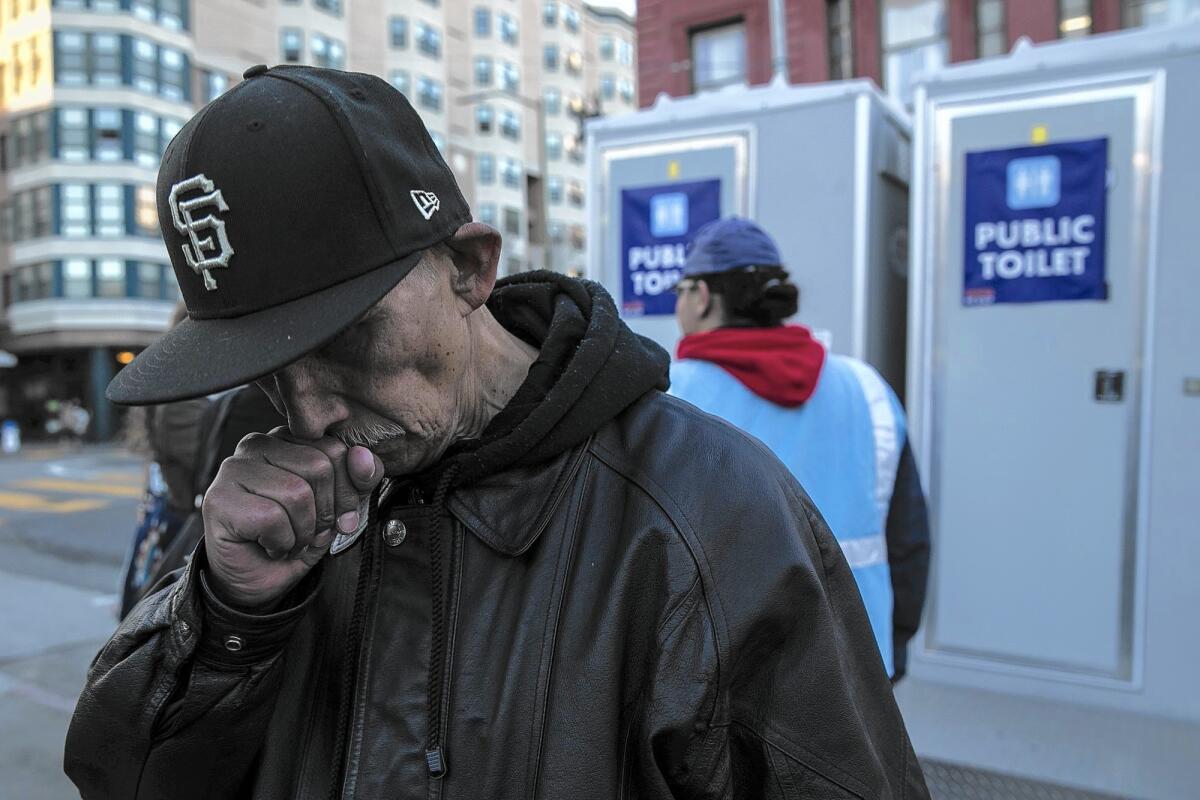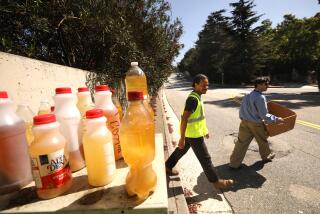San Francisco port-a-potty program offers homeless privacy, normality

- Share via
Reporting from San Francisco — San Francisco Chronicle columnist Herb Caen bemoaned in 1985 that his beloved city — particularly “the seamy streets of the Tenderloin” — risked the moniker of Latrine-by-the-Bay, in part because of official resistance to public toilets.
In the three decades since, the prevalence of human feces and urine in the neighborhood known for its large homeless population has posed a persistent policy and public-health dilemma.
The same could be said for Los Angeles and many other cities.
But on a recent evening, 49-year-old Mischa Fisher gazed at the Tenderloin Pit Stop with adoration. Homeless, Fisher has been compelled to do her most private business furtively in doorways or alleys when there is simply no other option.
Like many, she avoids the self-cleaning toilets that dot the city. They break often and double as dens for drug use and prostitution.
The pit stop program — which just completed a six-month pilot and is expected to be expanded and extended Tuesday by the Board of Supervisors — offers what at last could be a solution.
“It’s private, it’s clean, it has a sink, it has soap, it has seat covers, it has paper towels, it has a light,” Fisher said. “It’s wonderful. It’s a blessing. It’s the way I was raised.”
The pairs of toilets mounted on small trailers are mobile, hauled in Tuesdays through Fridays at 2 p.m. and hauled out at 9 p.m. for cleaning. Full-time attendants sporting blue jackets wipe them down, give each user a five-minute courtesy knock, and sweep the sidewalks while they’re at it.
Baggies for dog waste and a receptacle for used syringes are posted outside, addressing two other urban plagues.
Data drove the program’s development. One month alone saw 1,000 requests for steam cleaning of human feces citywide — more than half in the Tenderloin. Public works employees fanned out in the neighborhood, noting times and locations.
Three curbside sites chosen for the pilot are near soup kitchens and a park, the schedule extending to after-dinner hours.
During the last six months, steam-cleaning requests dropped by a third — a savings of 2,640 gallons of water a month — and use of the toilets doubled.
Most of all, supporters say, the program has restored basic dignity to people in the dense neighborhood.
“It’s one of the few things you can’t control,” said Supervisor Jane Kim, who championed the program. “You have to go to the bathroom. So to have the expectation that if we don’t provide this you’re magically going to find someplace else to go is not realistic.”
Heeding Caen’s call, San Francisco got its first self-cleaning toilet in 1995 from French company JCDecaux; there are 25 now. Although officials laud the company for responding promptly to breakdowns and vandalism, the unmonitored facilities have attracted illicit activity.
In 2008, Seattle pulled out its models, which cost about a quarter of a million dollars each to install and maintain. L.A.’s skid row has similarly struggled with pimping, prostitution and drug use at its five automated toilets, even finding computerized panels stripped by vandals.
“They are not utilized properly for their intended purpose,” said Gia Grant, executive director of the nonprofit San Francisco Clean City Coalition, which provides cleaning crews for the Tenderloin and staffs the pit stop facilities as part of a job training program.
For the last decade, she and other neighborhood advocates have clamored for a solution. A “toilet master plan” was created in 2012 after the group sent a man in his 40s — “not a homeless person, not a tourist, just a guy” — to restaurants and businesses around the neighborhood seeking to use a restroom. He didn’t have much luck.
At a town hall meeting last spring at a Tenderloin school, Public Works Director Mohammed Nuru listened as 10-year-old children described stepping around — or on — human waste and used syringes daily.
“It really touched my heart,” said Nuru, who vowed to “find a way to take this to another level.”
Kim considered the Portland Loo, a stainless-steel design with a slatted bottom to dissuade illicit activity that the Oregon city patented and has marketed for $90,000 to other municipalities, most recently San Diego and Arcata, Calif.
But Nuru was adamant that staffing was key.
“When you treat these facilities with a certain level of care, what you get is respect for the space,” he said. “I definitely was not thinking about leaving anything in the street unattended.”
For now, the city rents the solar-powered flushing port-a-potties. With staffing by Grant’s nonprofit, the six-month pilot cost $140,000; extending through June and adding a fourth in the South of Market neighborhood — approved by the board’s budget committee this month — will cost $203,000.
Water savings are a bonus, Kim said, and plummeting steam-cleaning requests have freed Nuru’s crews to focus on other parts of the city.
Nuru hopes to expand to weekends and eventually purchase as many as 30 toilets, handing the program to Grant’s group to manage. Also under discussion: posting attendants at automated toilets to cut down on misuse.
Supervisors representing the Haight-Ashbury and Mission districts want the toilets too, and Nuru’s department has fielded calls from Honolulu and New York City.
Alice Callaghan, a longtime Los Angeles advocate for the poor, fears the toilets would be too expensive for skid row. She believes a large number of facilities are necessary because safety issues can keep homeless people confined to one or two blocks.
She prefers a program launched by Mayor Richard Riordan (and eliminated by Mayor Antonio Villaraigosa because of business opposition) that spread construction site-style port-a-potties throughout the neighborhood.
“If something happened to one of them — they get destroyed or set on fire — the company would just haul it away and put down a new one,” said Callaghan, adding that “the issue is not really about the toilets, it’s about accommodating the homeless versus chasing them away.”
But in San Francisco, the project has “been more positive than I even imagined,” said Grant, who believes the neatly maintained facilities and clean sidewalks will lead to a shift in social behavior.
On a recent day, Gilbert Pelaiz wept while discussing the filth in his neighborhood. He maintains a collection of baseball caps and fedoras that he brushes daily and said he now feels pride in the pit stop program too.
“I really agree with this,” said Pelaiz, 64, who lives in one of many residential hotels nearby. “I know the girls who are working here and have developed a relationship with them. I feel good with them.”
Fisher also has befriended the attendants, visiting one site regularly to help tidy up inside and “pray for serenity.”
“This is the jungle,” she said, adding that plenty of people who dirty the streets with human waste “don’t care. But some of us do care.”
Twitter: @leeromney
More to Read
Sign up for Essential California
The most important California stories and recommendations in your inbox every morning.
You may occasionally receive promotional content from the Los Angeles Times.











